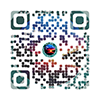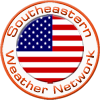Base Reflectivity Explained |

Taken from the lowest (½°) elevation scan, base reflectivity is excellent for surveying the region around the radar to look for precipitation. However, remember the radar beam increases in elevation as distance increases from the radar. This is due, in part, to the elevation angle itself but is more because the earth's surface curves away from the beam.
This can lead to underestimating the strength and intensity of distant storms. For this reason, it is wise to always check the radar images from different locations to help provide the overall picture of the weather in any particular area.

|
|
These dBZ values equate to approximate rainfall rates indicated in the table to the right of the image.
Concerning dBZ (decibels of Z): In normal clear air mode dBZ scales from -28 to +28 and scales from 0 to 75 in precipitation mode. Values above 45 dBZ signifies intense precipitation that is nearly always associated with thunderstorms. Anything above 60 dBZ generally means that the sample volume contains some hail.
These are hourly rainfall rates only and are not the actual amounts of rain a location receives. The total amount of rain received varies with intensity changes in a storm as well as the storm's motion over the ground.
Also, thunderstorms can contain hail which is often a good reflector of energy. Typically, a hailstone is coated with a thin layer of water as it travels through the thunderstorm cloud. This thin layer of water on the hailstone will cause a storm's reflectivity to be greater, leading to a higher dBZ and an over estimate the amount of rain received.
Value of 20 dBZ is typically the point at which light rain begins. The values of 60 to 65 dBZ is about the level where ¾" hail can occur. However, a value of 60 to 65 dBZ does not mean that severe weather is occurring at that location.
Severe weather may be occurring with values less (or greater) than 60 to 65 dBZ due to...
- Hail that is totally frozen (without a thin layer of water in the surface). "Dry hail" is a very poor reflector of energy and can lead to an underestimate of a storm's intensity.
- Atmospheric conditions such a ducting. When ducting occurs, the radar beam is refracted into the ground (indicating stronger storms than what are actually occurring). However a worse case is when subrefraction is occurring and the beam is overshooting the most intense regions of storms (indicating weaker storms than what are actually occurring).
- Doppler radars that get out of calibration. The radar can become "hot" (indicating stronger storms than what are actually occurring) or "cold" (indicating weaker storms than what are actually occurring).
NWS Radar Images
Whether looking at the standard or enhanced version of the NWS Doppler radar display the following examples of the different images applies to both varieties. In this section, the enhanced view will be used.
The National Weather Service provides several different images from the network of Doppler radars. These images include reflectivity, velocity and rainfall information.
Reflectivity Images
 These images are just as they sound as they paint a picture of the weather from the energy reflected back to the
radar. There are two types available on the web; Base (or ½° elevation) reflectivity
and Composite reflectivity.
These images are just as they sound as they paint a picture of the weather from the energy reflected back to the
radar. There are two types available on the web; Base (or ½° elevation) reflectivity
and Composite reflectivity. Base Reflectivity is the default image. Taken from the lowest (½° elevation) slice, it is the primary image used to "see what's out there". There are two versions of Base Reflectivity image; the short range version which extends out to 124 nm (about 143 miles) and the long range version which extends out to 248 nm (about 286 miles). This image is available upon completion of the ½° elevation scan during each 7 volume scan.
 Composite Reflectivity images utilize all elevation scans during each
volume scan to create the image. It is composed of the greatest echo intensity (reflectivity) from any elevation angle seen
from the radar. It is used to reveal the highest reflectivity in all echoes.
Composite Reflectivity images utilize all elevation scans during each
volume scan to create the image. It is composed of the greatest echo intensity (reflectivity) from any elevation angle seen
from the radar. It is used to reveal the highest reflectivity in all echoes.Another advantage of Composite Reflectivity is in mountainous regions. Often, the Base Reflectivity ½° elevation scan is not high enough to see over mountains. With the addition of higher elevations scans, weather information over mountain peaks can be seen. View a sample composite reflectivity image.
Velocity Images
 One of the best features on the 88d Doppler radar is its ability to detect motion. However, the
only motion it can "see" is either directly toward or away from the radar. This is called radial velocity
as it is the component of the target's motion that is along the direction of the radar beam.
One of the best features on the 88d Doppler radar is its ability to detect motion. However, the
only motion it can "see" is either directly toward or away from the radar. This is called radial velocity
as it is the component of the target's motion that is along the direction of the radar beam.Take it to the MAX! Radial Velocity
In all velocity images, red colors indicate wind moving away from the radar with green colors representing wind moving toward the radar. It is very important to know where the radar is located as that is your reference point for proper interpolation of the wind's motion.
Base Velocity images provides a picture of the basic wind field from the ½° elevation scan. It is useful for determining areas of strong wind from downbursts or detecting the speed of cold fronts. However, since the radar only measures radial velocity, the strength of the wind will always be less than what is actually occurring unless the wind is moving directly toward or away from the radar.
 Also, the surface winds are only for areas near the radar. As distance increases from the radar, the reported value will be for
increasing heights above the earth's surface. View
sample base velocity image.
Also, the surface winds are only for areas near the radar. As distance increases from the radar, the reported value will be for
increasing heights above the earth's surface. View
sample base velocity image. Storm Relative Motion images are very useful images to look for small scale circulations (called mesocyclones) in thunderstorms. Often, these small scale circulations are areas where tornadoes form.
What separates storm relative motion from base velocity is the motion of storms are "subtracted" from the overall flow of the wind. As storms move, their own motion can mask circulations within themselves. This motion is removed to make the view of the wind relative to the storm. In effect, what is seen is the wind's motion as if the storms were stationary. View a sample Storm Relative Motion image.
Precipitation Images
 There are two precipitation images made available via the web: One-hour Precipitation and Storm Total Precipitation. The maximum
range of these two images is 124 nm (about 143 miles) from the radar location. They will not display accumulated precipitation more
distant than 124 nm, even though precipitation may be occurring at greater distances. To determine accumulated precipitation at
greater distances you should link to an adjacent radar.
There are two precipitation images made available via the web: One-hour Precipitation and Storm Total Precipitation. The maximum
range of these two images is 124 nm (about 143 miles) from the radar location. They will not display accumulated precipitation more
distant than 124 nm, even though precipitation may be occurring at greater distances. To determine accumulated precipitation at
greater distances you should link to an adjacent radar. One-hour Precipitation is an image of estimated one-hour precipitation accumulation. It is used to
assess rainfall intensities for flash flood warnings, urban flood statements and special weather statements.
View a sample One-hour Precipitation image.
One-hour Precipitation is an image of estimated one-hour precipitation accumulation. It is used to
assess rainfall intensities for flash flood warnings, urban flood statements and special weather statements.
View a sample One-hour Precipitation image.Storm Total Precipitation image is of estimated accumulated rainfall, continuously updated, since the last one-hour break in precipitation. This product is used to locate flood potential over urban or rural areas, estimate total basin runoff and provide rainfall accumulations for the duration of the event. View a sample Storm Total Precipitation image.
Always check the time frame from which this image is created. There must be one hour without precipitation anywhere on the radar before the accumulation period begins again and, depending upon the weather patterns, that may be up to several days.
Weather Warnings
 If any portion of a county is affected by severe weather, the NWS issues a weather warning for the entire county. However,
we actually refine the region affected by drawing the warnings in polygons to indicate the exact region we believe severe weather may
occur.
If any portion of a county is affected by severe weather, the NWS issues a weather warning for the entire county. However,
we actually refine the region affected by drawing the warnings in polygons to indicate the exact region we believe severe weather may
occur.Included with the radar images are graphics of severe weather warnings. (These images can be hidden on the enhanced views of the Doppler radar by toggling off the warnings.) The colors, red, yellow, green and blue represent the four types of warnings that will appear on NWS Doppler radar images.
- Red - Tornado Warning. Issued when a tornado is imminent or occurring. A Tornado Warning implies an immediate threat to life and property.
- Yellow - Severe Thunderstorm Warning. Issued when a severe thunderstorm is imminent or occurring. A severe thunderstorm is defined as hail ¾" or greater and/or a wind speed of 58 mph or greater.
- Green - Flash Flood Warning. Issued with flash flooding is imminent or occurring.
- Marine - Special Marine Warning. Issued for hazardous weather conditions (thunderstorms over water, thunderstorms that will move over water, cold air funnels over water, or waterspouts) usually of short duration (2 hours or less) and producing sustained winds or frequent gusts of 34 knots or more that is not covered by existing marine warnings.










